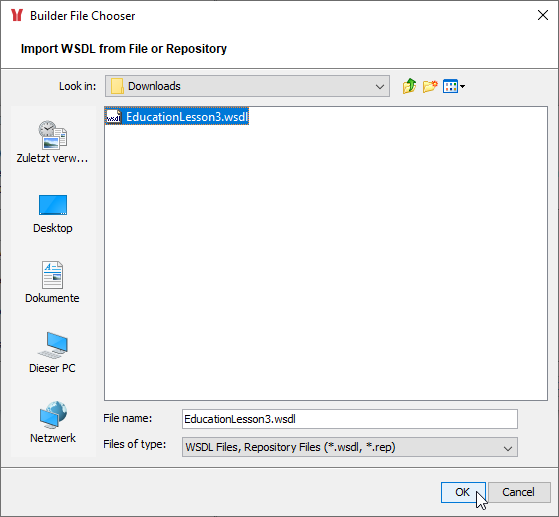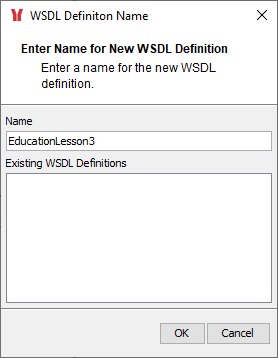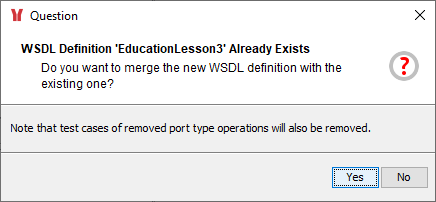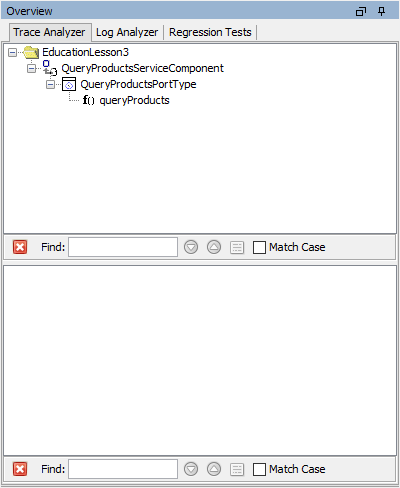- Created by Kirstin Seidel-Gebert, last modified by Simon Wack on Sep 19, 2023
The Trace Analyzer features testing of a service after importing its WSDL file. The web service definition can be imported from
a WSDL file (.wsdl)
a URL providing the WSDL file
an xUML service repository file (.rep)
a WSDL file (.wsdl) in combination with a bridgeserver log file (.log)
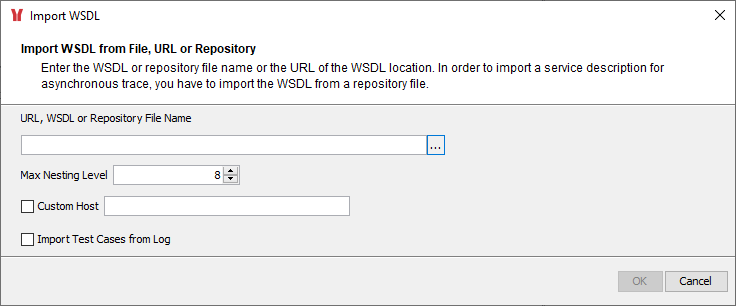
You can use the WSDL importer with the following options:
- The import of the service description can be controlled by a maximum nesting level. The maximum nesting level specifies the maximum depth of the WSDL structure to be considered by the Analyzer. Elements on a level deeper than specified are not considered. RPC encoded test cases will not run in this case.
- You can replace the service location coming from the WSDL by a custom host. This is helpful, if you are importing the WSDL from a repository. In this case, you will get localhost as service location, and you would have to modify this default location to the real endpoint of the test on each test case.
- If you have a bridgeserver log file (in addition to the corresponding WSDL file), that contains logged service calls, you can import these service calls as test cases into the Trace Analyzer. For more information see Importing Test Cases from a Bridgeserver Log further below.
If you are provided with a URL to a WSDL location, enter that URL here. Some companies and organizations offer a collection of their web service operations in WSDL files. For instance, check out xMethods (http://www.xmethods.net), where you will find publicly available web services.
Choose an example, and run it on the external site. Then copy the URL, import the example service, and run it in the Trace Analyzer.
If you have the WSDL file or repository file on hand that you want to import, enter the file name or click ![]() to open a file browser.
to open a file browser.
| In the file chooser dialog, navigate to the folder containing the file (e.g. the WSDL file). For testing purposes, you find a WSDL file attached to this page. Select the WSDL file EducationLesson3.wsdl and click OK. |
Confirm the import of the selected service description by clicking OK.
| Next, you may enter a descriptive name for the imported WSDL. Existing WSDLs are listed in the lower text box for orientation. You can also select the corresponding entry from the list in the lower text box if you want to overwrite a test definition. |
| If you enter an existing WSDL name, you'll get the warning, that the WSDL definition in the Analyzer will get overwritten. All test case information of newly imported port type operations will be cleared. |
| The imported service description has been saved in the Trace Analyzer. You can create a test case for any port type operation and send a SOAP request to the external Web Service. If you re-import a service that already has some test cases present, it may that these older test cases will be marked as outdated (means "coming from an older service version"). That depends on test meta data having changed or not. You can run these test cases nevertheless - this is just to remind you that problems running such tests may be the result of an outdated test case version (see also Outdated Test Cases). |
Importing Test Cases from a Bridge Service Log
When running a service with Bridge Log Level "Debug", the Bridge, among others, logs service calls to the bridgeserver log. If you have a bridgeserver log file (in addition to the corresponding WSDL file), that contains logged service calls, you can import these service calls as test cases into the Trace Analyzer. This is useful for generating test cases for e.g. regression testing.
To import a service description in combination with a bridgeserver log file, check Import Test Cases from Log in the import dialog. For testing purposes, you find a WSDL file and a bridgeserver log file attached to this page.
After the import of the service description, the importer will prompt for a log file.
| In the file chooser dialog, navigate to the folder containing the bridgeserver log file. Select the log file bridgeserver_2023-09-01.log and click OK. |
The imported WSDL file has been saved in the Trace Analyzer. Additionally, test cases - along with their request and response - have been created from the information provided by the bridgeserver log. The test case names are generated from the the name of the port type operation with numbering added.

For managing test cases see Managing Test Cases.
- No labels
